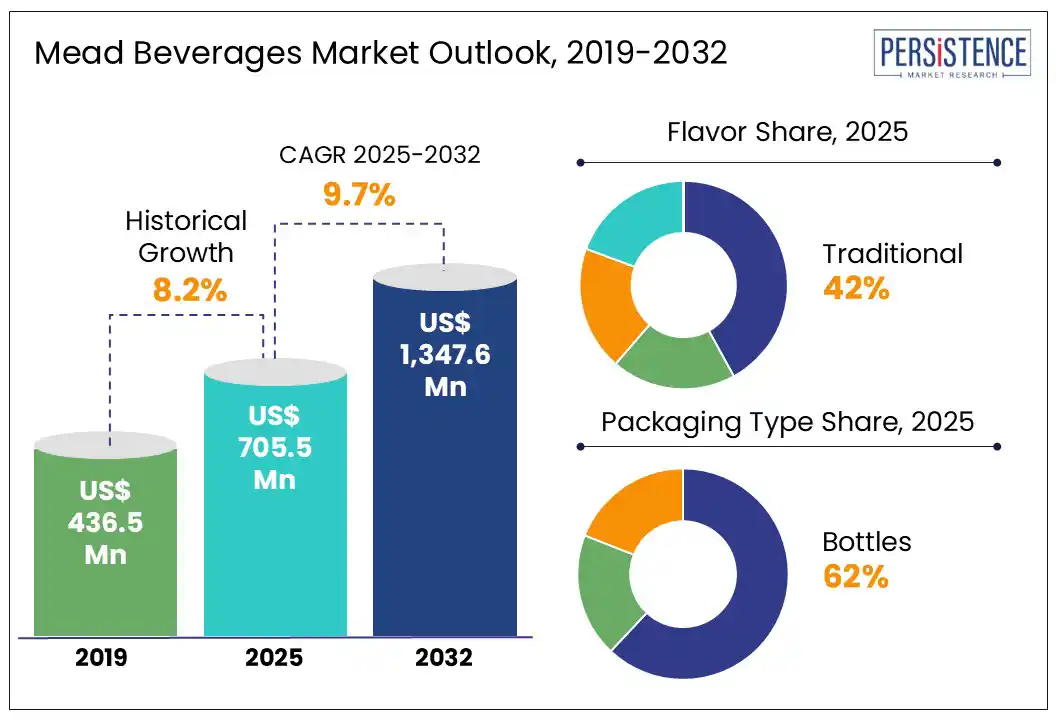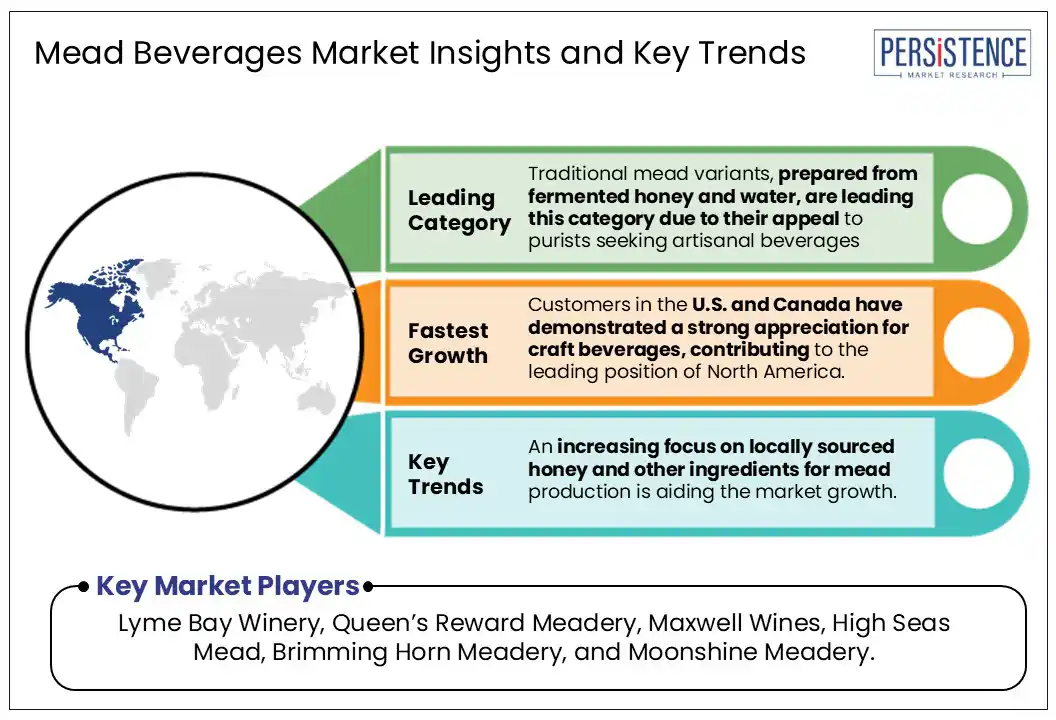ID: PMRREP34734| 191 Pages | 11 Jul 2025 | Format: PDF, Excel, PPT* | Food and Beverages

The global mead beverages market size is likely to be valued at US$ 705.5 Mn in 2025 and is estimated to reach US$ 1,347.6 Mn in 2032, at a CAGR of 9.7% during the forecast period 2025 - 2032.
Mead, also known as honey wine, is a beverage made from honey, water, and yeast, with the occasional addition of fruits. Mead is considered one of the oldest alcoholic beverages; mead beverages are making a steady comeback in the modern alcohol industry, propelled by a growing consumer interest in libations with a rich heritage. Its resurgence in the modern era is also attributable to the rising demand for craft beverages, especially among the young. The mead beverages market stands to make significant gains in this scenario, as mead offers a varied taste profile and is compatible with current health trends.

Key Industry Highlights
|
Global Market Attribute |
Key Insights |
|
Mead Beverages Market Size (2025E) |
US$ 705.5 Mn |
|
Market Value Forecast (2032F) |
US$ 1,347.6 Mn |
|
Projected Growth (CAGR 2025 to 2032) |
9.7% |
|
Historical Market Growth (CAGR 2019 to 2024) |
8.2% |
Consumers today are gravitating toward artisanal and specialty beverages over mass-produced ones to enjoy a more customized and enhanced drinking experience. This tendency is highly noticeable in the mead industry, which can pull drinkers by offering historical beverages with distinct flavor characteristics. Alcohol companies are tapping into this broader trend wherein drinkers prefer genuine, high-quality beverages that have a high vintage value. The mead beverages market growth is expected to be driven by the unique blend of innovation and history that mead offers to new-age alcohol enthusiasts, creating opportunities for long-term development of this niche drink.
Unlike popular alcohol options, such as beer and wine, mead beverages are still relatively unknown in modern consumer markets, despite their history and distinct taste. Generally speaking, consumers hesitate to experiment with new offerings, and instead prefer to stick to tried-and-tested, familiar products. As a result, mead producers are finding it challenging to attract consumers, limiting the expansion of the mead beverage market.
A growing number of individuals are reassessing their dietary habits, focusing on avoiding the consumption of processed foods and drinks to prevent the onset of lifestyle-linked chronic diseases, such as diabetes and obesity. This has created a wide spectrum of opportunities for meaderies to formulate low-sugar and probiotic alternatives for health-conscious consumers. The integration of probiotics into mead beverages, which supports gut health, also corresponds with the increasing interest in functional drinks among modern drinkers.
Another area that mead producers can tap into is the infusion of exotic fruit flavors into their products to provide an eclectic blend of taste for more nuanced consumers. Mead companies can also develop new concoctions with spices, such as ginger, to further expand their offerings to consumers. These opportunities are set to brighten the mead beverages market outlook in the near future.
By flavor, the market has been divided into traditional, fruit, spice & herb, and floral. The traditional segment is anticipated to lead, accounting for a market share of 42.0% in 2025. Traditional mead variants, primarily concocted from fermented honey and water, are leading this category due to their appeal to purists seeking artisanal beverages, based on the historical authenticity they provide.
On the other hand, fruit meads, such as those prepared from berries and apples, are gaining popularity, especially among younger consumers, for their more refined, and diverse flavor profiles. Meaderies can blend different fruit flavors to attract new consumers and deepen their footprint in this market.
By packaging type, this market is categorized into bottles, cans, and kegs. The bottles segment is expected to dominate, holding a 62% market share, as glass bottles remain the preferred packaging type for mead. The main reason for this continued reliance on bottles is that they preserve the quality and flavor of mead while appealing to consumers who value traditional packaging and presentation.

North America is likely to lead, accounting for a market share of 34.0% and is expected to continue dominating the market through 2032. Customers in the U.S. and Canada have demonstrated a strong appreciation for artisanal and small-batch products, contributing to the region's well-established craft beverage industry. Due to this, craft meaderies are growing at a rate similar to brewers, wineries, and distilleries. With its many flavor profiles and rich history, mead is a fantastic fit for the region's open-minded consumers who are eager to try new and unusual beverages.
General accessibility and availability of mead are supported by North America's well-developed e-commerce sector and robust retail and distribution infrastructure for alcohol. The increasing availability of mead at restaurants, specialized liquor stores, and online marketplaces has simplified the process for customers to learn about and buy mead, adding to its expanding appeal.
Europe is projected to grow steadily over the forecast period. Superior, artisanal beverages are highly valued in the European market, where consumers have sophisticated palates. This societal tendency toward handcraft has spurred the rise of specialized and boutique meaderies that concentrate on making high-quality, small-batch meads.
Many of the taste profiles offered by mead appeal to European customers. Meads that include fruit, herbs, and spices from the area are particularly well-liked, as they align with the region's emphasis on terroir and locally derived goods.
The market is expanding due to the increased appeal of mead festivals and other cultural events around Europe. These events provide a platform for educating customers and increasing awareness of mead, which frequently honors local heritage and traditional crafts. This increases the demand for mead and contributes to a significant market growth in Europe.
The global mead beverages market is a niche yet a rapidly growing segment. Branding and marketing are essential in the mead market's highly competitive environment. Manufacturers are investing in eye-catching packaging, imaginative label designs, and captivating brand narratives that accentuate the distinctive features and historical significance of their products. Many meaderies also use digital marketing and social media to interact with customers directly, sharing their mead stories and creating a community among drinkers.
The market is projected to reach US$ 705.5 Mn in 2025.
Increasing consumer interest in craft beverages and growing demand for low-sugar alcohol options are key market drivers.
The market is poised to witness a CAGR of 9.7% from 2025 to 2032.
Key market opportunities include the integration of probiotics and the infusion of fruit and spice flavors in meads.
The key players in the global mead beverages market include Lyme Bay Winery, Queen’s Reward Meadery, and Maxwell Wines.
|
Report Attribute |
Details |
|
Historical Data/Actuals |
2019 - 2024 |
|
Forecast Period |
2025 - 2032 |
|
Market Analysis Units |
Value: US$ Mn |
|
Geographical Coverage |
|
|
Segmental Coverage |
|
|
Competitive Analysis |
|
|
Report Highlights |
|
|
Customization and Pricing |
Available upon request |
By Flavor
By ABV
By Packaging Type
By Distribution Channel
By Region
Delivery Timelines
For more information on this report and its delivery timelines please get in touch with our sales team.
About Author